Can I Overfeed My Baby Solid Food?
- Why portion sizes really don't matter because there are no set portion sizes for babies…just keep things small to reduce food waste and offer your baby a variety of foods
- When to worry about your baby jumping up or down on their growth chart…but also how most growth chart aberrations are results of poor data and inaccurate measurement. Always measure and weigh your baby at home before you go to the doctor, just to keep them honest in their tracking!
- What to do if your baby eats too much food at once…but why it's less than you think because with baby-led weaning, the baby learns to listen to and respond to their hunger and fullness cues, so you're kind of off the hook!
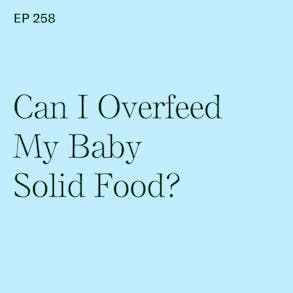
LISTEN TO THIS EPISODE
Episode Description
What if my baby eats too much food? Can babies overeat with baby-led weaning? In this episode, we’re exploring concerns from parents and caregivers about babies who (their words) “eat too much.” We’ll look at portion sizes…and why there are no set portion sizes for babies as well as safety concerns, hunger and fullness cues, and then why your baby’s growth chart is actually the best indicator of whether or not they’re getting enough nutrition from food.
Need more ideas of foods your baby safely CAN eat? Grab your copy of my original 100 FIRST FOODS list on this free one-hour online video training called BABY-LED WEANING FOR BEGINNERS. Sign up here: https://babyledweaning.co/
The small portion-sized suction mats that I mentioned in this episode are the ezpz Mini Mats. I like that they remind us to keep baby’s portion sizes small - and to offer a variety of foods during the weaning process. If you’re shopping the ezpz Mini Mats you cna get 10% off everything at ezpzfun.com with my affiliate ezpz discount code KATIE10.
Right now I’m really digging the growth chart app I mentioned in the episode called…wait for it…Growth! You can enter your baby’s height and weight from their doctor appointments and well checks and keep an eye on their path to health in this app which you can find here: https://apps.apple.com/us/app/growth-baby-child-charts/id446639811
Safety matters when starting solid foods and we talk about how overstuffing can lead to choking in some instances. Make sure you’ve taken a refresher infant CPR course before starting solid foods. The CPR class I take each quarter is linked here and you can get an extra $10 off that class with my affiliate discount code KATIE10. The Choking Prevention and Response course I co-teach is also linked and code KATIE10 works for 10% off there too.
…and there were LOTS Of other growth related BLW podcast episodes I’ve recorded and expert interviews that were mentioned in this episode. You can find them all on the shownotes page located here: https://blwpodcast.com/258
Follow baby-led weaning with Katie Ferraro @babyledweanteam on Instagram: https://www.instagram.com/babyledweanteam/
Subscribe to the baby-led weaning YouTube channel with new videos every Tuesday and Friday: https://www.youtube.com/c/babyledweaning
Thank you for being a part of this amazing baby-led weaning community. If you like this BLW podcast, please would you kindly leave me a review on Apple Podcasts? This really helps the podcast get found by other parents, caregivers and healthcare professionals and I get my best future episode ideas from your reviews. Click here to leave a review on Apple Podcasts and Happy Feeding! -Katie
Links from This Episode
I mentioned quite a few other resources in this episode - here are links, some of which are affiliate links meaning I earn a small amount of money when you also support these small businesses:
- Ezpz feeding gear, my affiliate discount code works BABYLED for 15% off all of these 100% foodgrade silicone suction mats and bowls:
- ezpz Mini Mats
- ezpz Mini Bowls
- ezpz Tiny Bowls
- CPR - take an infant refresher CPR course before you start solid foods. This is the CPR class I take and recommend and my affiliate discount code KATIE10 works for 10% off CPR and the Choking Prevention and Response Course I also co-teach here.
- Baby-Led Weaning with Katie Ferraro program with the 100 First Foods™ Daily Meal Plan, join here: https://babyledweaning.co/program
- Baby-Led Weaning for Beginners free online workshop with 100 First Foods™ list to all attendees, register here: https://babyledweaning.co/baby-led-weaning-for-beginners
Other Episodes Related to this Topic
I mentioned quite a few other mini training BLW episodes I have done or interviews I have conducted with feeding experts in this interview. The growth related episodes are all linked for you here - save them and listen later if you don’t have time to right now:
- Episode 54 - Overstuffing: What If My Baby Takes Big Bites? with Dawn Winkelmann, MS, CCC-SLP
- Episode 215 - Portion Distortion: Why Aren't There Set Portion Sizes for Baby-Led Weaning?
- Episode 110 - Catch-Up Weight: Why Starting Solids Early Will Not Help Your Baby Gain Weight with Rosan Meyer, PhD, RD
- Episode 77 - Baby Hunger & Fullness Cues: What They Are & How to Spot Them
- Episode 133 - Don’t Drip Food: How to Pre-Portion for Baby-Led Weaning
- Episode 55 - How to Drop a Milk Feed

Latest Episodes
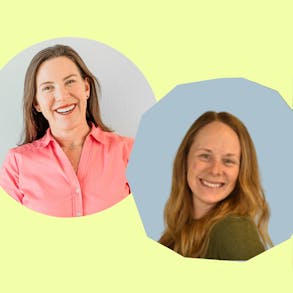
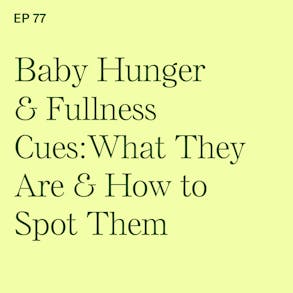
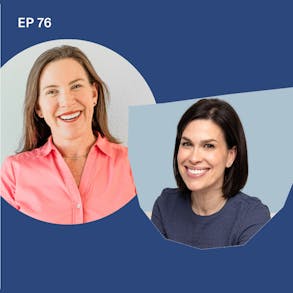
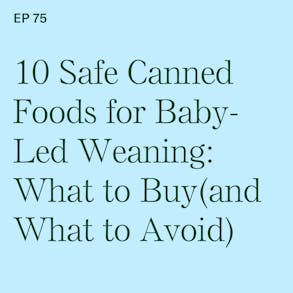
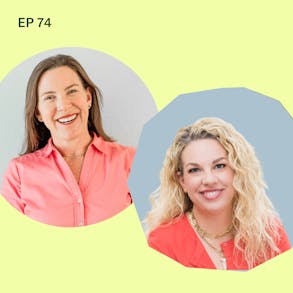
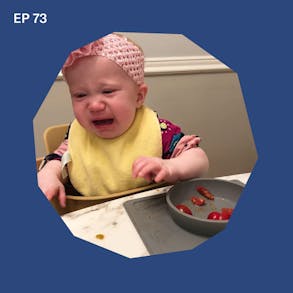
Katie Ferraro (0s):
All right. Quick pulse check. Are you feeling okay about baby Led Weaning a little nervous about this transition? Are you maybe interested in BLW but not entirely sure if this is the approach for you or maybe you started baby Led weaning, but you're feeling stuck or you're going to give up cause you're not sure if you're doing this right. Don't give up. I have a brand new one hour comprehensive online video training for you called Baby Led Weaning for BEGINNERS. It's totally free. And I think it's going to ease a lot of anxiety for you. I just redid this free training its packed with videos and visuals on how to safely prepare BLW Foods and what the first few days looks like and how to reduce choking risk. Plus everyone on this free workshop gets a copy of my 100 FIRST FOODS LIST.
Katie Ferraro (41s):
So you'll never run out of ideas about what to feed your baby next. You can get signed up for this weeks video workshop times at babyledweaning.co. If you've got one hour to dedicate to learning about BLW, this is the training for you babyledweaning.co has this week's workshop times. And don't forget you also get that hundred FIRST FOODS LIST from this free training. And I hope to see you there And with this approach, because your baby is the one driving the intake and bringing the food to their mouth, eventually chewing and swallowing, and then stopping when they learn to feel what fullness is. The potential to overfeed with baby Led Weaning it's almost non-existent. Hey there I'm Katie Ferraro, Registered Dietitian college nutrition, professor and mom of seven specializing in baby Led Weaning here on the baby Led Weaning Made Easy podcast.
Katie Ferraro (1m 26s):
I help you strip out all of the noise and nonsense about feeding, leaving you with the competence and knowledge you need to give your baby a safe start to solid foods using baby Led Weaning. Well, hello and welcome back today. Today we're talking about over feeding your baby. And in particular, this came from a question on a workshop I was teaching this week and a mom said I am so worried that my baby eats too much. He always seems to be hungry. Can I Overfeed My Baby Solid Food? So in today's episode, I want to talk through a couple of the points surrounding this fear or this concern that parents may have about over feeding their baby a solid food.
Katie Ferraro (2m 12s):
So let's start out with, I always like to answer the well, who cares question is this worth talking about? Who cares? I'll be honest with you. A lot of parents and caregivers worry about this. There's like two schools of thought here. Some parents are like, oh my gosh, I wish my baby would even touch the food. There's no risk of my baby over eating because they're not eating anything right now, but it will happen for you, right? We always talk about how it can take days, weeks, sometimes, even months for babies to get the hang of self-feeding. But then sometimes parents will come back and be like, ah, now I'm worried that my baby is eating too much and am I making it worse? And I want to start out with it is very, very, very unlikely that you are overfeeding your baby solid foods.
Katie Ferraro (2m 52s):
Okay. There's a very, very rare condition and it's called Prader-Willi syndrome. And I'm not actually going to spend a ton of time talking about it though, but it's a genetic multi-system disorder and it's characterized kind of interesting early in life. These infants actually have poor refluxes and poor sucking ability and feeding difficulties and failure to thrive. And then later on in life, generally between four and a half and eight years old, their appetite and their caloric intake kind of goes through the roof. And then they develop this need to eat an extraordinary large amount of food it's called hyperphasia. And they don't feel satisfied after completing a meal. So they don't have those feelings of satiety. It's one of the, the hallmark signs, attributes of Prader-Willi syndrome, but it's incredibly and extremely rare.
Katie Ferraro (3m 34s):
So it's actually like listed under like the rare diseases of the world. So I don't want to say that it's impossible for a child to have a condition whereby they quote unquote overeat. There's certainly other underlying conditions and medications in particular that can cause a child to overeat. But for the most part, when we're talking about infants six to 12 months of age, it's very unlikely that you are overfeeding your baby solid food. Having said that, let's talk a little bit about some of the concerns. If you're worried that your baby's quote unquote, eating too much. I want you to leave this episode today, not worrying about that. Let's talk first about safety.
Katie Ferraro (4m 14s):
Sometimes parents ask, well, gosh, my baby is so voracious in their appetite. They love it when they sit down and they have all this food that I worry because they shove all this food in their mouth. It can be uncomfortable for you to watch that, but unless your baby is actively choking, we actually don't intervene. So this concept of overstuffing, we actually did a podcast episode on this with Dawn Winkelmann. Who's a speech language pathologist, and baby led weaning expert. If you're worried about your baby, overstuffing be sure to listen to episode number 54, it's called Overstuffing. What if my baby takes big bites? But in that we kind of talk about these different scenarios and different types of food and baby putting a lot in their mouth. But at the end of the day, there's some tweaks that you can make to help your baby pace their own food intake.
Katie Ferraro (4m 59s):
But again, with baby Led Weaning, we want baby to be the one driving the eating experience. So we don't want to start dripping food. Dripping food, if you've ever heard of it, dripping is like, when you put a piece of food out at once and then the baby eats it, and then you put another piece of food out and then the baby eats it. We don't want to drip food. I did a whole podcast episode on dripping food too. If you've never heard this term before, you're like, I've been doing that, but why is it not the best idea? That's episode number 133. And that is called don't drip food. How to pre portion food for baby Led Weaning. So if your baby is actively choking, yes, you would want to intervene.
Katie Ferraro (5m 41s):
But the reality is most of the time with overstuffing, there's no actual choking going on your baby is learning about how to put different quantities of food in their mouth, and then what to do with it at the different ages and stages. I do always encourage parents though, to have taken an infant refresher CPR course before they start solid foods. Okay. Choking is a very rare but real risk. I want you to be prepared, okay. In the rare event that your baby does have a choking incident. Having those infant refreshers CPR skills under your belt will give you the skill set that you need to intervene. Should it be necessary? So I have an online CPR course that I take myself each quarter. I love this class. I, it always helps me refresh my skills.
Katie Ferraro (6m 22s):
I'm always working with different babies. There's always the risk of course, that babies or older kids, adults that you encounter could choke on foods or other household objects. So it's nice to have those skills and I need them at least quarterly for myself, but you probably took a CPR course before you had your baby. It's important to make sure you do it before you start solid foods. So I actually have an affiliate discount code for the online course. I take through Thrive Training Institute. My code is KATIE10. I'll link up the page where I, I have my CPR course that I take from them. They teach it. And then I actually also, co-teach a choking prevention course with that speech language pathologist, Dawn Winkelmann and the thrive training CPR instructor.
Katie Ferraro (7m 4s):
And I'll put all of those on the same page and link them up for you. If you guys want to grab $10 off the code is Katie10 to do online CPR or choking prevention, but having those skills so you can be, you know, watching for safety issues is very important. So being concerned about safety is one thing. Another thing I want to talk about is portion size. A lot of times in the conversation about overfeeding baby solid foods, I just did a baby Led Weaning ask me anything question box on Instagram today. And there was two different questions about portions. I'm nervous I don't know how big the portion should be for baby led weaning. And then someone asked like, what's the exact portion size of, they actually asked about chia seed, which was kind of interesting, cause that's not a food I regularly offered to babies. We'll start with the regular portion size and then I'll answer the chia seed part.
Katie Ferraro (7m 47s):
But there are no such things as set portion sizes for babies. Whenever you see other pages or, you know, bloggers talking about portion sizes and download my portion size guide, they're making it up. Okay. There are no evidence-based portion sizes for infants. Okay? We are in the transitional period, complimentary foods where we're focusing in baby led weaning from six to 12 months on letting your baby explore and learn how to eat foods. I do not want you to be preoccupied about how much food they're eating. So I have some general guidance and kind of some guard rails for portion sizes. I did a whole episode, 215 about portion distortion.
Katie Ferraro (8m 27s):
Why aren't there set portion sizes for baby Led Weaning, go and listen to that if you want more guidance. But when it comes to quote-unquote portion sizes, the reminder is to keep the foods small. So we always remember that babies don't eat very much. And sometimes parents will say, oh, baby led weaning so wasteful, I make all this food and they never eat it. No, you make all this food, but you offer it over and over and over and over again, right? A baby might need to see a food 10 or 15 times before they like or accept it, but there's no set amount that you quote unquote need to feed. If you are eyeballing your baby's portion sizes, I always encourage you to keep those portions small for portioning out food. So we don't drip them. We want to pre portion them. I like to put the foods in a suction mat.
Katie Ferraro (9m 8s):
I use the mini mat from the company. EZPZ the mini mat looks like a little smile. It's got two eyeballs in a smile pocket. There's 2 two ounce portions for the eyeballs and a four ounce portion for the smile. I just said, oh, there's no set portions. But those are the actual, especially for the dieticians who need to know the ounces. Those are the portion sizes 2 two ounce portions in one, four ounce pocket. But the point is you only put a small amount of food in those, especially early on in baby Led Weaning. You like to leave some room around the food so that the baby can use their whole hand or their palmer grasp to rake and scoop the foods up and out of those portion pockets. And I love the EZPZ products. They were designed by their feeding expert. They've got a pliable silicone rim. Okay. And that's important because it bends backwards.
Katie Ferraro (9m 49s):
So your baby can rake and scoop that food up even before they have their pincer grasp. And I just think the mini mat is such a good visual reminder for us to keep the portion sizes small for our baby and also to offer a variety of different foods. So if you're shopping for EZPZ, I am an affiliate for them. My affiliate discount code is KATIE10. If you want to get 10% off everything at EZPZ. And again, I like their mini mat for baby Led Weaning. I also use their tiny bowl and I use their miny bowl for baby Led Weaning. So those are my three favorite suction mats. And again, I'll put them in the show notes, if you want to check them out or see pictures of them. So when it comes to portions, there's no set sizes as portions. So you can't really overdo it. You do want to keep them small.
Katie Ferraro (10m 29s):
You do want to offer a variety of food. Now there's definitely and I see it all the time over force-feeding of food. Can I Overfeed My Baby Solid food? If you're letting your baby feed themselves, the answer is no because your baby inherently knows when to stop, right? Babies turn their head away from the breast or away from the bottle when they're full of milk. They also have the capacity to tell us with their cues when they're getting full of food. Now, keep in mind that early on in baby led weaning, your baby is not eating in response to hunger. When we're talking about observing hunger and fullness cues, that's really for older babies. Okay? And so I did a whole episode. If you're like, I don't know what their cues are.
Katie Ferraro (11m 11s):
Go check out episode 77 it's baby hunger and fullness cues, what they are and how to spot them. So we never want to encourage baby to quote unquote, eat everything on their plate, or you got to eat everything that I made for you. Babies should be regulating their own intake and they will eventually learn to stop eating when they get full. Okay. So the whole weaning period is a practice period where at the beginning of it at six months, they have no idea what they're doing and they're not eating in response to hunger and they don't stop because they're full. But a few weeks and months go by, we generally drop a milk feed at around the eight month mark. Okay. And I did a whole, you guessed it, a whole podcast episode on how to drop a milk feed. It's one of our most downloaded episodes its episode 55.
Katie Ferraro (11m 53s):
And that's a really good one to listen to if you're like, oh, my baby's kind of getting the hang of baby led weaning, but I don't know if it's time to drop a milk feed. Once you do that around the eight month mark, a few more weeks go. And then generally everything kind of clicks right then. Then we drop a second milk feed now our babies are eating in response to hunger. That's true weaning in action with our ultimate goal of baby, getting most of their nutrition from food by the time your baby turns one, but that doesn't happen overnight, right? That's what we use the weaning period for it's a practice period. But I do see parents who sometimes get stressed and maybe baby's not eating enough. So they'll shove a pouch into their mouth or they'll start kind of forcing them to eat foods, which we never want to do. That's definitely not baby Led Weaning.
Katie Ferraro (12m 33s):
And I know some of you worry, well, I feel like I need to push extra calories into my baby because my baby's a preemie or a micro preemie, or I was told by the doctor that they need some catch-up weight. And it's very, very, very important to note that any recommendation in infancy, especially in the middle part of infancy around six and seven months of age for your baby to use foods to promote catch-up weight, that's a very inappropriate recommendation. Okay? We never recommend babies. Quote, unquote, being forced to eat extra calories, to help with catch-up weight. Okay. We did a whole episode on this episode, 110 called catch-up weight. Why starting solids early will not help your baby gain weight with Rosanne Meyer.
Katie Ferraro (13m 15s):
She's a PhD, pediatric dietician. She really specializes in growth charts and growth faltering, and what used to be called failure to thrive. And we talk about this pressure that parents hear about, well, my baby needs to catch up and the doctor says they need calories from food, very inappropriate recommendation to be using food for extra calories at a period before the baby even knows how to safely eat food. You should be working with a pediatric dietician fortifying infant milk long before you ever would modify foods for catch-up weight. So that's episode 110, if that's happening to you as well. So we want you to obviously be concerned about baby's safety. If they are eating quote unquote too much and choking on it. Yes, we would need to know those CPR skills, but more often than not, baby just needs time to learn how to work the food around their mouth and take smaller bites.
Katie Ferraro (14m 1s):
We need to avoid dripping the food which we talked about. Cause we want your baby to be able to kind of have that visual regulation of how much food is on the plate and then how much food are they bringing in their mouth and how fast are they chewing it and eventually swallowing it. And then they'll learn when to eat in response to hunger and to stop in response to fullness, but they'll never do it if we're the ones driving the feeding experience. So sit back and let your baby do the thing that they are biologically equipped to do. And we want to avoid force feeding. We want to keep those portions small and varied foods. As I mentioned, if you're short on ideas of foods that your baby can eat, you're like, ah, three new foods in that mini-mat, don't do three new foods a day. If you guys are following my five step feeding framework, we introduce one new food a day.
Katie Ferraro (14m 44s):
On Monday, we do a new fruit, on Tuesday we do a new vegetable, on Wednesday we do a new starchy food, on Thursday we do a protein food, and on Friday we do a new allergenic food and those five foods from the five food categories. Those are the five pillars of my hundred FIRST FOODS LIST. Every day we pick a food from one of the five categories. We need five new foods a week, right? In one month, your babies had 20 foods in five months, your babies had a hundred foods all before they turned one. If you want to grab a copy of my hundred FIRST FOODS LIST, I give it away to everybody on my free one hour online video workshop training called BABY LED WEANING FOR BEGINNERS, you can sign up for this week's workshop times and grab a copy of that original a hundred FIRST FOODS LIST.
Katie Ferraro (15m 24s):
If you go to babyledweaning dot.co I never want you guys to run out of ideas of a variety of foods that your baby can eat. Now, the last thing that I wanted to mention with regards to this safety consideration is to keep an eye on your baby's growth chart. Okay. I've been using this app on my phone for tracking the babies that I work with. I also put all of my own kids' stuff in there. It's so fun. It's called growth app. It's a free app. Go online, go back and get those papers. You know, when you leave the doctor's office at the six month appointment, and then the nine month appointment plug in your baby's height and weight, I save all of them for the baby book, but no one cares about it. And the baby book, I'm like, this is such a silly thing to save, but then I put it into the growth app and watching your baby's growth chart tracking that's the best indicator of how their nutrition status is going.
Katie Ferraro (16m 10s):
Okay. If your baby falls off their growth curve or goes way high on their growth curve, yes, that would be cause for concern. You would definitely want to talk to your pediatrician about that. And if necessary involve the help of a pediatric dietician who can help you get quote unquote, back on track. Now, growth charts oftentimes give a lot of unnecessary anxiety because if your baby falls off the growth chart, parents are like, oh my gosh, I'm a terrible mom. You're not more often than not the aberrations on the growth path so if baby falls off or goes way up. It has to do with a measurement error. If, think about how they get height and weight in your doctor office, it tends to be very not scientific weight is scientific, cause there's a scale which hopefully is calibrated and your baby's not sitting on it with a wet diaper toys, et cetera.
Katie Ferraro (16m 54s):
But the height measurement in pediatrician's office is notoriously inaccurate. And so back in that episode, 110 with Rosanne Meyer, her whole thing like is all about proper interpretation of growth charts. And it's a huge, huge area. It's a very problematic area that parents are getting inaccurate data about their baby's height. And then if you plot it wrong on the growth chart, it makes your baby look like, oh my gosh, they fell off the growth chart. When oftentimes it's just because of one or two inches that they got wrong, right? Cause they push the baby down on the table. In most offices, they mark the feet, they mark the head and then they measure in between it very rarely is a doctor's office, at least in the United States in your general pediatrician's office, are they using a stadiometer, okay. Recumbent length is what we want for babies and getting Rosanne teaches all about this in episode 110, but was there a solid hardboard that your baby's height was measured on the last time they measured their height?
Katie Ferraro (17m 44s):
I would almost guarantee the answer is no. So just know that a lot of time, the errors in growth chart tracking have to do with errors in measurment, okay. And that's why we're getting inaccurate data. So I always encourage parents measure your baby and weigh your baby at home before you go. Plot it yourself on the growth chart, you can plot these yourself. You can download the growth chart for free. If you want to, or the growth app is way easier, but I would just encourage you to keep an eye on your baby's growth chart because that's the best indicator of how you're doing. And it is, again, is very, very unlikely that you are overfeeding your baby solid food, a link of all of the resources, including all the different episodes. Cause if you're listening to this, I know you're a little concerned about your baby's growth. And I want to make sure that you listen to those other episodes. Especially when I lived in the various experts, in their areas of expertise to talk about these topics.
Katie Ferraro (18m 27s):
It's so important that we're getting our infant feeding information from credentialed experts. I've got myself as well as lots of other guests on the podcast and the link of all of the resources from today's episode for you on the show notes, which you can find if you go to BLWpodcasts.com/258. Thanks so much for listening and I'll see you next time.

The Program Baby-Led Weaning with Katie Ferraro
A step-by-step digital program for starting solid foods safely and navigating the original 100 FIRST FOODS™ meal plan with baby-led weaning.
 EXPERT-LED, PROVEN APPROACH TO EATING REAL FOOD
EXPERT-LED, PROVEN APPROACH TO EATING REAL FOOD CONCISE VIDEO TRAININGS TO MASTER BABY-LED WEANING
CONCISE VIDEO TRAININGS TO MASTER BABY-LED WEANING 100 FIRST FOODS DAILY MEAL PLAN WITH FOOD PREP VIDEOS
100 FIRST FOODS DAILY MEAL PLAN WITH FOOD PREP VIDEOS
Baby-Led Weaning for Beginners Free Workshop
Is your baby ready to start solid foods, but you’re not sure where to start? Get ready to give your baby a solid foundation to a lifetime of loving real food…even if you’re feeling overwhelmed or confused about this next stage of infant feeding.
Get baby-led weaning recipes and tips delivered to your email inbox.

